I thought it would be interesting make a simple post about the several musical scales and Mathematica.
I know there are many and very good posts on this topic, about timing, chord and music construction, that´s not what I approach here. I just wanted to do one post on a simple form about the different scales, so that a person not so experienced could enjoy. Here is shown in a very simple way the relationship between the musical notes in various scales and tones, frequency of the notes in hertz and the many sonorities. Samples of the scales with various instruments, only for fun and knowledge.
Below are the 30 musical scales that I address in this post:

As already explained in the Documentation, the note chosen by convention to be the integer frequency is the A of 440 hertz, from which all other notes are calculated:
440*(2^(n/12) // DisplayForm)

Example of other note frequencies:
Do[Print@N[440*2^(n/12)], {n, -5, 5}]

This conventional A note is similar to the numerical value 9 in coding by Mathematica. Below is the A 440 hertz generated by both the frequency and the numerical value stipulated by the program. In this example the duration is 1 second:
{Play[Sin[2*Pi*440*t], {t, 0, 1}], Sound@SoundNote[9, 1]}

Mathematica uses as the base value the middle C note (C4, or C of the fourth octave ) which is represented by the numerical value 0 in the program. This value is 9 semi-tones (or 9 numeric values) below A 440 hertz and has a frequency of approximately 261,626 hertz. Below is this middle C generated both by the default value 0 of Mathematica and by the value generated using the frequency:
{Sound@SoundNote[0, 1], Play[Sin[2*Pi*440*2^(-3/4)*t], {t, 0, 1}]}

An example of how to find the numeric notes and their respective frequency by equation:
Do[Print[{n, N[440*2^((n - 9)/12)]}], {n, -10, 10}]

Here is a brief summary of the notes in Mathematica, their frequencies and their tones:
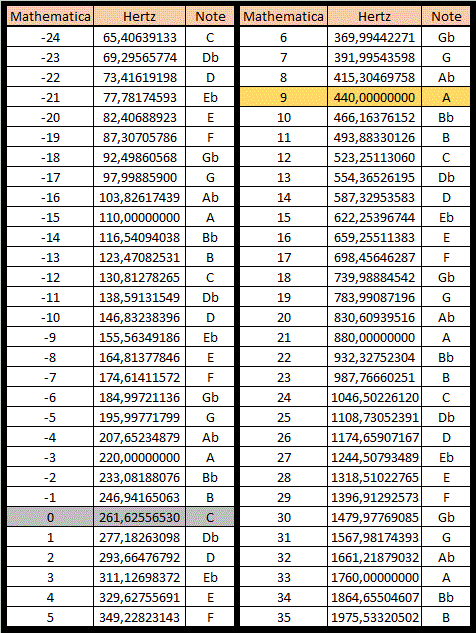
Since in this post I show several musical scales which have different tones ( Gb, F, G, Ab... ), it is interesting to know how to make the change of tones. Below is an example of how to change tones in any scale shown here. For example, if we take the major pentatonic in Gb and want it in A, we need to add 3 in the numerical value of all the scale notes: Gb (-18 for example) to A (-15 for example) we need to add 3. Below is a tone conversion for this example scale:
MajorPentatonicGb = {-18, -16, -14, -11, -9, -6, -4, -2, 1, 3, 6, 8};
MajorPentatonicA = 3 + MajorPentatonicGb
MajorPentatonicA /. {-20 -> "E", -19 -> "F", -18 -> "Gb", -17 ->
"G", -16 -> "Ab", -15 -> "A", -14 -> "Bb", -13 -> "B", -12 ->
"C", -11 -> "Db", -10 -> "D", -9 -> "Eb", -8 -> "E", -7 ->
"F", -6 -> "Gb", -5 -> "G", -4 -> "Ab", -3 -> "A", -2 ->
"Bb", -1 -> "B", 0 -> "C", 1 -> "Db", 2 -> "D", 3 -> "Eb",
4 -> "E", 5 -> "F", 6 -> "Gb", 7 -> "G", 8 -> "Ab", 9 -> "A",
10 -> "Bb", 11 -> "B", 12 -> "C"}

Here is a simple function for listening to the sound of the different scales ( in a gentler way, not too complicated ) and the numerical sequence code of the scales. Then the instruments used are varied only for better contemplation as well as intervals of notes, but any of the scales may have other intervals and instrumentation:
mf[a_, b_, c_] := Module[{n},
n = Take[Flatten@RandomSample@Join[Subsets[a, {3, 7}],
Map[Sort[#, Greater] &, Subsets[a, {3, 7}]],
Map[RandomSample, Subsets[a, {2, 5}]]], 1000];
Sound@Map[SoundNote[#, (1 + RandomReal[{-0.1, 0.1}])*b, c] &, n]]
MajorPentatonic = {-18, -16, -14, -11, -9, -6, -4, -2, 1, 3, 6, 8};
MinorPentatonic = {-19, -16, -14, -12, -9, -7, -4, -2, 0, 3, 5, 8};
NeopolitanMajor = {-19, -18, -17, -15, -13, -11, -9, -7, -6, -5, -3, \
-1, 1, 3, 5, 6, 7, 9};
NeopolitanMinor = {-18, -17, -15, -13, -11, -10, -7, -6, -5, -3, -1,
1, 2, 5, 6, 7, 9};
HungarianMajor = {-18, -15, -14, -12, -11, -9, -8, -6, -3, -2, 0, 1,
3, 4, 6, 9};
HungarianMinor = {-19, -18, -16, -15, -12, -11, -10, -7, -6, -4, -3,
0, 1, 2, 5, 6, 8, 9};
HungarianGypsy = {-19, -17, -15, -13, -11, -10, -9, -7, -5, -3, -1, 1,
2, 3, 5, 7, 9};
HarmonicMajor = {-19, -18, -16, -14, -13, -11, -10, -7, -6, -4, -2, \
-1, 1, 2, 5, 6, 8};
HarmonicMinor = {-19, -18, -16, -15, -13, -11, -10, -7, -6, -4, -3, \
-1, 1, 2, 5, 6, 8, 9};
DoubleHarmonic = {-17, -16, -15, -12, -11, -9, -8, -5, -4, -3, 0, 1,
3, 4, 7, 8, 9};
JazzMinor = {-19, -18, -16, -15, -13, -11, -9, -7, -6, -4, -3, -1, 1,
3, 5, 6, 8, 9};
Overtone = {-19, -17, -15, -13, -11, -10, -8, -7, -5, -3, -1, 1, 2, 4,
5, 7, 9};
BluesScale = {-19, -16, -14, -13, -12, -9, -7, -4, -2, -1, 0, 3, 5, 8};
Chromatic = {-15, -14, -13, -12, -11, -10, -9, -8, -7, -6, -5, -4, \
-3, -2, -1, 0, 1, 2, 3, 4, 5, 6, 7, 8, 9};
WholeTone = {-19, -17, -15, -13, -11, -9, -7, -5, -3, -1, 1, 3, 5, 7,
9, 11, 13, 15};
DiminishedWholeTone = {-18, -17, -15, -14, -12, -10, -8, -6, -5, -3, \
-2, 0, 2, 4, 6, 7, 9};
Symmetrical = {-19, -17, -16, -14, -13, -11, -10, -8, -7, -5, -4, -2, \
-1, 1, 2, 4, 5, 7, 8};
Arabian = {-19, -17, -15, -13, -12, -11, -9, -7, -5, -3, -1, 0, 1, 3,
5, 7, 9};
Balinese = {-19, -18, -16, -12, -11, -7, -6, -4, 0, 1, 5, 6, 8};
Byzantine = {-19, -18, -17, -14, -13, -11, -10, -7, -6, -5, -2, -1, 1,
2, 5, 6, 7};
Persian = {-19, -18, -17, -14, -13, -12, -10, -7, -6, -5 - 2, -1, 0,
2, 5, 6, 7, 10};
EastIndianPurvi = {-19, -18, -17, -14, -12, -11, -10, -7, -6, -5, -2,
0, 1, 2, 5, 6, 7};
Oriental = {-19, -18, -16, -15, -12, -11, -10, -7, -6, -4, -3, 0, 1,
2, 5, 6, 8, 9};
GagakuRyoSenPou = {-18, -16, -14, -11, -9, -6, -4, -2, 1, 3, 6, 8};
Zokugaku = {-19, -16, -14, -12, -9, -7, -4, -2, 0, 3, 5, 8};
InSenPou = {-19, -18, -14, -12, -11, -7, -6, -2, 0, 1, 5, 6};
Okinawa = {-19, -18, -14, -13, -11, -7, -6, -2, -1, 1, 5, 6};
Enigmatic = {-19, -18, -17, -14, -12, -10, -8, -7, -6, -5, -2, 0, 2,
4, 5, 6, 7, 10};
EightToneSpanish = {-18, -16, -15, -13, -12, -11, -10, -8, -6, -4, \
-3, -1, 0, 1, 2, 4, 6, 8, 9};
Prometheus = {-18, -16, -14, -12, -9, -8, -6, -4, -2, 0, 3, 4, 6, 8};
Below are the examples of the scales that can be played by the musical function shown above:
Has 5 scale notes. The image below is an exemplificative tone C and the scale sample is in Gb tone: { Gb, Ab, Bb, Db, Eb }.

mf[MajorPentatonic, 0.22, "Guitar"]
Has 5 scale notes. The image below is an exemplificative tone C and the scale sample is in F tone: { F, Ab, Bb, C, Eb }.

mf[MinorPentatonic, 0.22, "Guitar"]
Has 7 scale notes. The image below is an exemplificative tone C and the scale sample is in Gb tone: { Gb, G, A, B, Db, Eb, F }.
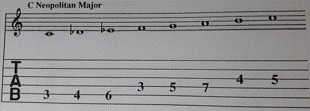
mf[NeopolitanMajor, 0.22, "ElectricBass"]
Has 7 scale notes. The image below is an exemplificative tone C and the scale sample is in Gb tone: { Gb, G, A, B, Db, D, F }.
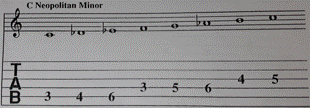
mf[NeopolitanMinor, 0.22, "ElectricBass"]
Has 7 scale notes. The image below is an exemplificative tone C and the scale sample is in Gb tone: { Gb, A, Bb, C, Db, Eb, E }.

mf[HungarianMajor, 0.23, "SteelGuitar"]
Has 7 scale notes. The image below is an exemplificative tone C and the scale sample is in Gb tone: { Gb, Ab, A, C, Db, D, F }.

mf[HungarianMinor, 0.23, "SteelGuitar"]
Has 7 scale notes. The image below is an exemplificative tone C and the scale sample is in G tone: { G, A, B, Db, D, Eb, F }.

mf[HungarianGypsy, 0.18, "Glockenspiel"]
Has 7 scale notes. The image below is an exemplificative tone C and the scale sample is in Gb tone: { Gb, Ab, Bb, B, Db, D, F }.
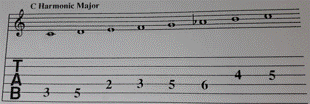
mf[HarmonicMajor, 0.2, "ElectricGrandPiano"]
Has 7 scale notes. The image below is an exemplificative tone C and the scale sample is in Gb tone: { Gb, Ab, A, B, Db, D, F }.

mf[HarmonicMinor, 0.2, "Piano"]
Has 7 scale notes. The image below is an exemplificative tone C and the scale sample is in Ab tone: { Ab, A, C, Db, Eb, E, G }.
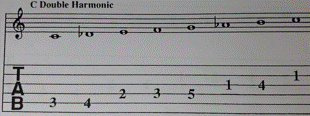
mf[DoubleHarmonic, 0.15, "Guitar"]
Has 7 scale notes. The image below is an exemplificative tone C and the scale sample is in Gb tone: { Gb, Ab, A, B, Db, Eb, F }.

mf[JazzMinor, 0.18, "GuitarHarmonics"]
Has 7 scale notes. The image below is an exemplificative tone C and the scale sample is in G tone: { G, A, B, Db, D, E, F }.
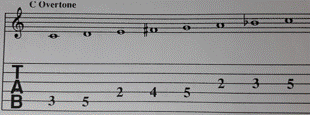
mf[Overtone, 0.22, "Crystal"]
Has 6 scale notes. The image below is an exemplificative tone C and the scale sample is in F tone: { F, Ab, Bb, B, C, Eb }.

mf[BluesScale, 0.33, "ElectricPiano"]
Has 12 scale notes. The image below is an exemplificative tone C and the scale sample is in A tone: { A, Bb, B, C, Db, D, Eb, E, F, Gb, G, Ab }.

mf[Chromatic, 0.17, "PanFlute"]
Has 6 scale notes. The image below is an exemplificative tone C and the scale sample is in F tone: { F, G, A, B, Db, Eb }.

mf[WholeTone, 0.2, "PizzicatoStrings"]
Has 7 scale notes. The image below is an exemplificative tone C and the scale sample is in Gb tone: { Gb, G, A, Bb, C, D, E }.

mf[DiminishedWholeTone, 0.24, "ElectricBass"]
Has 8 scale notes. The image below is an exemplificative tone C and the scale sample is in G tone: { G, Ab, Bb, B, Db, D, E, F }.
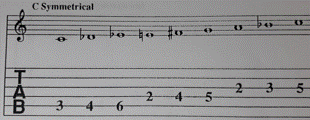
mf[Symmetrical, 0.17, "Guitar"]
Has 7 scale notes. The image below is an exemplificative tone C and the scale sample is in G tone: { G, A, B, C, Db, Eb, F }.
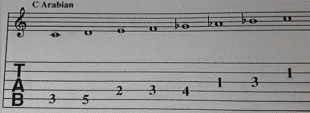
mf[Arabian, 0.3, "Cello"]
Has 5 scale notes. The image below is an exemplificative tone C and the scale sample is in F tone: { F, Gb, Ab, C, Db }.
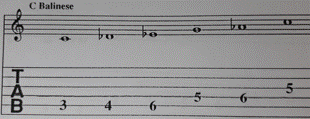
mf[Balinese, 0.31, "Banjo"]
Has 7 scale notes. The image below is an exemplificative tone C and the scale sample is in Gb tone: { Gb, G, Bb, B, Db, D, F }.
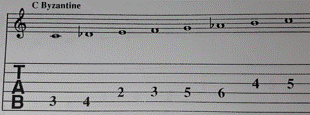
mf[Byzantine, 0.23, "Bandoneon"]
Has 7 scale notes. The image below is an exemplificative tone C and the scale sample is in Gb tone: { Gb, G, Bb, B, C, D, F }.
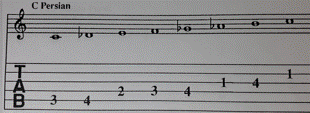
mf[Persian, 0.3, "Tuba"]
Has 7 scale notes. The image below is an exemplificative tone C and the scale sample is in Gb tone: { Gb, G, Bb, C, Db, D, F }.

mf[EastIndianPurvi, 0.25, "Sitar"]
Has 7 scale notes. The image below is an exemplificative tone C and the scale sample is in Ab tone: { Ab, A, C, Db, D, F, Gb }.
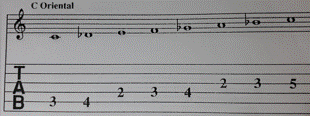
mf[Oriental, 0.3, "GuitarMuted"]
Has 5 scale notes. The image below is an exemplificative tone C and the scale sample is in Gb tone: { Gb, Ab, Bb, Db, Eb }.
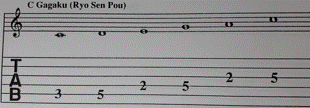
mf[GagakuRyoSenPou, 0.2, "Harp"]
Has 5 scale notes. The image below is an exemplificative tone C and the scale sample is in F tone: { F, Ab, Bb, C, Eb }.
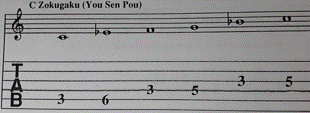
mf[Zokugaku, 0.32, "Shamisen"]
Has 5 scale notes. The image below is an exemplificative tone C and the scale sample is in F tone: { F, Gb, Bb, C, Db }.

mf[InSenPou, 0.28, "Guitar"]
Has 5 scale notes. The image below is an exemplificative tone C and the scale sample is in Gb tone: { Gb, Bb, B, Db, F }.
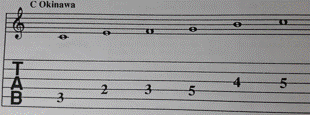
mf[Okinawa, 0.42, "Agogo"]
Has 7 scale notes. The image below is an exemplificative tone C and the scale sample is in Gb tone: { Gb, G, Bb, C, D, E, F }.
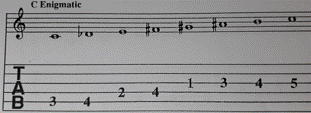
mf[Enigmatic, 0.2, "ElectricPiano2"]
Has 8 scale notes. The image below is an exemplificative tone C and the scale sample is in Ab tone: { Ab, A, B, C, Db, D, E, Gb }.
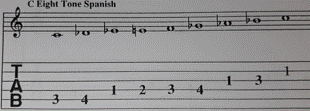
mf[EightToneSpanish, 0.18, "Crystal"]
Has 6 scale notes. The image below is an exemplificative tone C and the scale sample is in Gb tone: { Gb, Ab, Bb, C, Eb, E }.
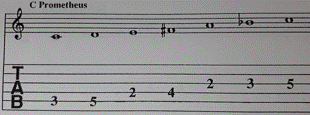
mf[Prometheus, 0.28, "Organ"]
The images with the scales above came from the Mel Bay's Complete Guitar Scale Dictionary, by Mike Christiansen.
I hope this post is useful to someone in the community, or someone who just likes to appreciate the different sounds of the scales.
Thank you very much.